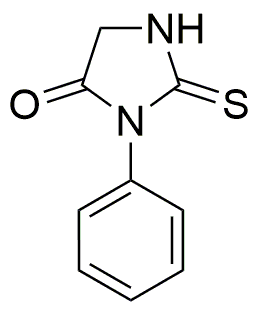Phenylthiohydantoin-glycine is widely utilized in research focused on
- Protein Sequencing: This compound is used in Edman degradation, a method for sequencing amino acids in proteins, allowing researchers to determine the structure and function of proteins in various biological systems.
- Peptide Synthesis: It serves as a building block in the synthesis of peptides, which are crucial in drug development and therapeutic applications, particularly in designing targeted treatments for diseases.
- Biochemical Assays: The compound is employed in biochemical assays to study enzyme activity and interactions, providing insights into metabolic pathways and potential drug targets.
- Analytical Chemistry: It is used in chromatography techniques for the separation and analysis of complex mixtures, enhancing the accuracy of chemical analysis in pharmaceuticals and environmental testing.
- Research in Neurobiology: Researchers utilize this compound to investigate neuropeptides and their roles in neurological functions, contributing to the understanding of brain chemistry and potential treatments for neurological disorders.
General Information
Properties
Safety and Regulations
Applications
Phenylthiohydantoin-glycine is widely utilized in research focused on
- Protein Sequencing: This compound is used in Edman degradation, a method for sequencing amino acids in proteins, allowing researchers to determine the structure and function of proteins in various biological systems.
- Peptide Synthesis: It serves as a building block in the synthesis of peptides, which are crucial in drug development and therapeutic applications, particularly in designing targeted treatments for diseases.
- Biochemical Assays: The compound is employed in biochemical assays to study enzyme activity and interactions, providing insights into metabolic pathways and potential drug targets.
- Analytical Chemistry: It is used in chromatography techniques for the separation and analysis of complex mixtures, enhancing the accuracy of chemical analysis in pharmaceuticals and environmental testing.
- Research in Neurobiology: Researchers utilize this compound to investigate neuropeptides and their roles in neurological functions, contributing to the understanding of brain chemistry and potential treatments for neurological disorders.
Documents
Safety Data Sheets (SDS)
The SDS provides comprehensive safety information on handling, storage, and disposal of the product.
Product Specification (PS)
The PS provides a comprehensive breakdown of the product’s properties, including chemical composition, physical state, purity, and storage requirements. It also details acceptable quality ranges and the product's intended applications.
Certificates of Analysis (COA)
Search for Certificates of Analysis (COA) by entering the products Lot Number. Lot and Batch Numbers can be found on a product’s label following the words ‘Lot’ or ‘Batch’.
Numéro de catalogue
Numéro de lot/série
Certificates Of Origin (COO)
This COO confirms the country where the product was manufactured, and also details the materials and components used in it and whether it is derived from natural, synthetic, or other specific sources. This certificate may be required for customs, trade, and regulatory compliance.
Numéro de catalogue
Numéro de lot/série
Safety Data Sheets (SDS)
The SDS provides comprehensive safety information on handling, storage, and disposal of the product.
DownloadProduct Specification (PS)
The PS provides a comprehensive breakdown of the product’s properties, including chemical composition, physical state, purity, and storage requirements. It also details acceptable quality ranges and the product's intended applications.
DownloadCertificates of Analysis (COA)
Search for Certificates of Analysis (COA) by entering the products Lot Number. Lot and Batch Numbers can be found on a product’s label following the words ‘Lot’ or ‘Batch’.
Numéro de catalogue
Numéro de lot/série
Certificates Of Origin (COO)
This COO confirms the country where the product was manufactured, and also details the materials and components used in it and whether it is derived from natural, synthetic, or other specific sources. This certificate may be required for customs, trade, and regulatory compliance.


